20th November 2018
Bernard Fortin, general manager of Peace River Logging talks about the transition from infield chipping to an off-highway, centralized wood yard and the accompanying improvements in operational efficiency.

The chipping operation. A Tigercat 875 unloads the forwarding trailers and stacks the tree length wood for the chipper.
Peace River Logging is a fourteen-year-old company based in Peace River, Alberta, a solid five-hour drive in a northwest direction from Edmonton. Peace River Logging is a 50/50 joint venture between Daishowa-Marubeni International Ltd. (DMI) and Woodland Cree First Nation, and was established to supply hardwood chips to the DMI Peace River Pulpwood Division Mill. The mill’s chip intake is 2,4 million cubic metres and it can produce up to 475 000 tonnes of air-dried kraft pulp annually. Harvesting operations take place on a 2,9 million hectare (7.2 million acre) forest management area in northwestern Alberta.
As Bernard explains, Peace River Logging started in 2004, initially as an in-woods chipping operation. An intensive winter harvesting and chipping effort was followed by an often prolonged spring break-up, and then a move to drier summer ground. “We were running out of summer ground and that would mean more winter chipping. We didn’t have the facility to handle more volume in a short period of time, so we wanted to spread it out over a longer period of time.” Bernard also wanted to keep the crew working year-round. “We always had three to four months off for the spring. We have had as high as five months off. Then you lose your key employees.” So last year Bernard put together a proposal to set up a wood yard where the company would stockpile and chip year round.
The proposal was accepted and next Peace River Logging negotiated to purchase a 130 hectare (320 acre) tract close to the end of the mill’s private haul road and just sixteen kilometres (10 mi) from the mill. “Our future plan is to build a shop on the property as well,” states Bernard.
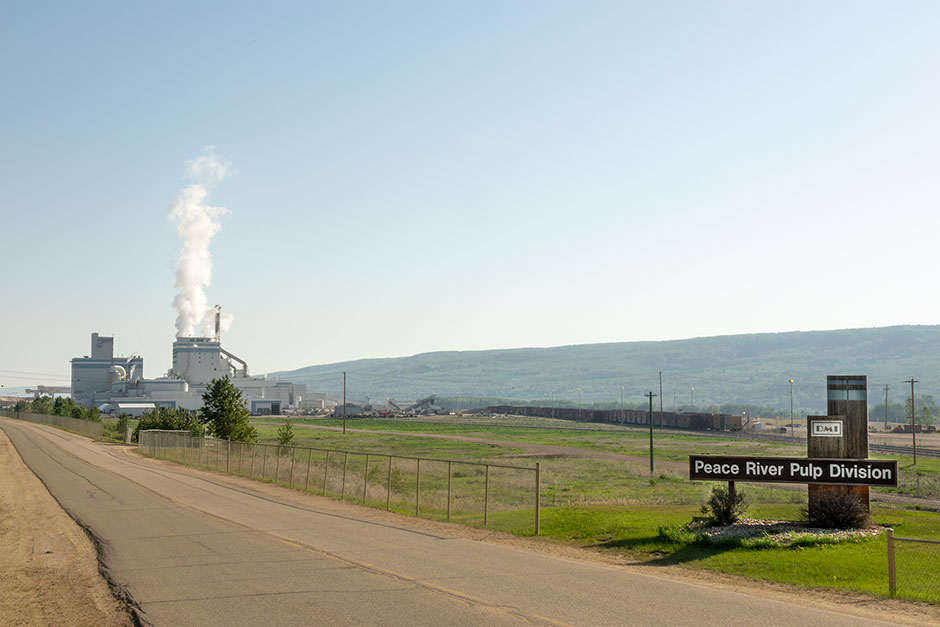
The past winter was a season of transition for the team as they set up at the new wood yard all the while harvesting and hauling 300 000 cubic metres of tree-length wood – enough to last to November 2018 – from the harvesting site 130 km (80 mi) up the road. “We had to up our production last year,” explains Bernard. “Because we were still bush chipping last season, we were harvesting and hauling tree length at the same time so last year was kind of like two seasons in one in order to get our volume in the yard.” In addition to supplying chips to DMI, the company also supplies logs to Boucher Bros Lumber Ltd. in Nampa. “We did about 149 000 cubic metres for them last year and I think this coming season is going to be about 170 000 metres.”
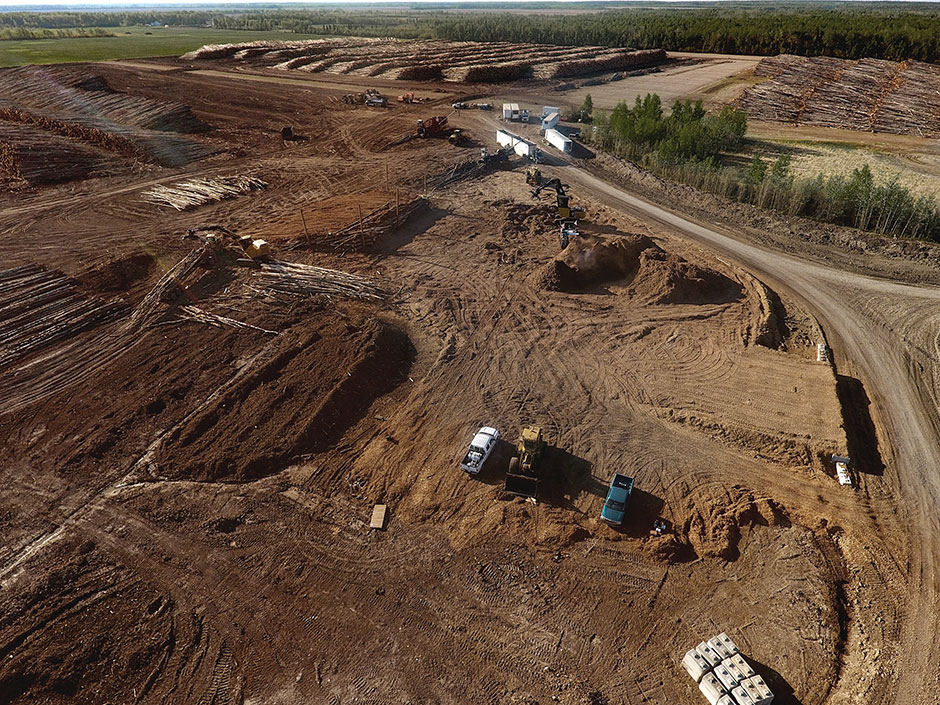
The bottleneck of the operation has always been chipping and trucking. Before starting the new remote chipping yard, the company was running up to fourteen chip trucks.
While things moved along fairly efficiently in the midst of the winter deep freeze, it was always a short window and then Bernard found himself dealing with all manner of complications.
“When you have a dry year, it’s not bad but when you get a wet year, some months we barely worked. A lot of the time we pump water off of the haul roads, to clear them so that we can get back in there. Then we finally get the road shaped up and then we get another shower and we are down another week. In the meantime, we have guys sitting at camp and we’d get them to do a bunch of stuff – road maintenance, getting prepared to chip again, pumping water, and you do all that stuff, but you can only do so much.”
So the challenge was not only to find enough summer ground to harvest but also to deal with the 160 km (100 mi) private haul road itself. “You could have a light shower and the bush is nice and dry but your trucks can’t haul because it rained down the road. So here, rain or shine we can haul. And here we can maximize our equipment. We can do the same volume with one chipper because we can run seven days a week versus five days a week.”
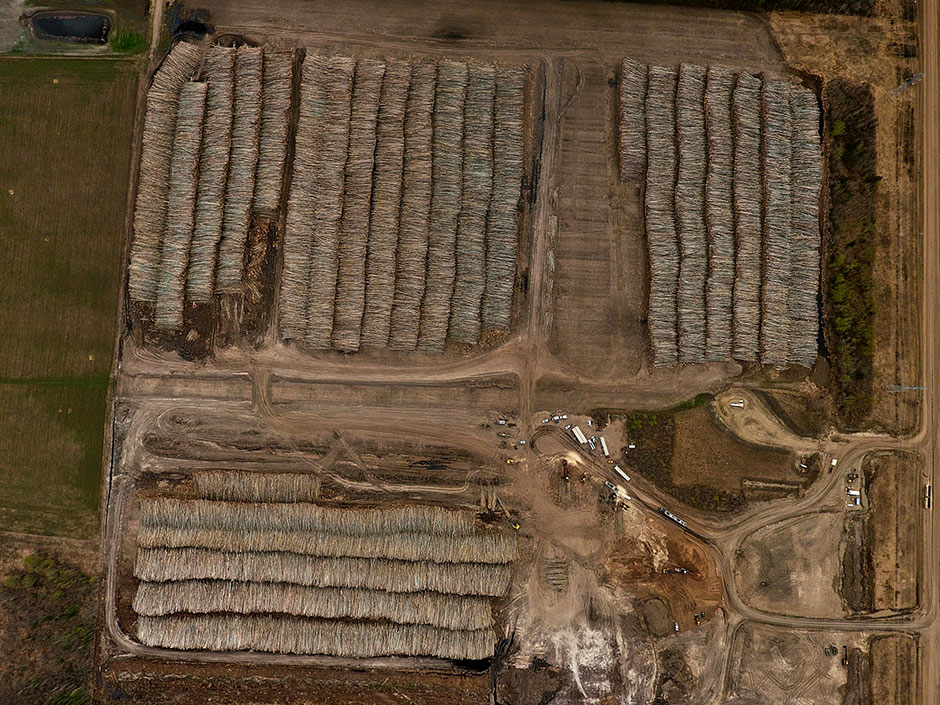
A bird’s eye view of the wood yard. Peace River stockpiled 300 000 cubic metres of tree-length timber during the 2017-2018 winter logging season– enough to see the chipping operation through to November 2018.
Previously, Peace River Logging was running two chippers infield plus one spare with as many as fourteen on-highway haul trucks. The chippers were operating five days per week, 24 hours per day. With the new system in place, one chipper operates seven days per week, 24 hours per day, with one spare in case of breakdown. During winter, fourteen trucks with modified trailers haul tree length from the cut block to the yard. This past winter the off-highway trucks were typically hauling 50 tonne payloads. Two super-B chip vans are making the 32 km round trip to the mill around the clock, providing consistent delivery of twenty 42 tonne loads every 24 hours. In addition, Bernard is maintaining more year-round employment. One of the objectives of Peace River Logging is to create employment for the Woodland Cree First Nation and the local community.
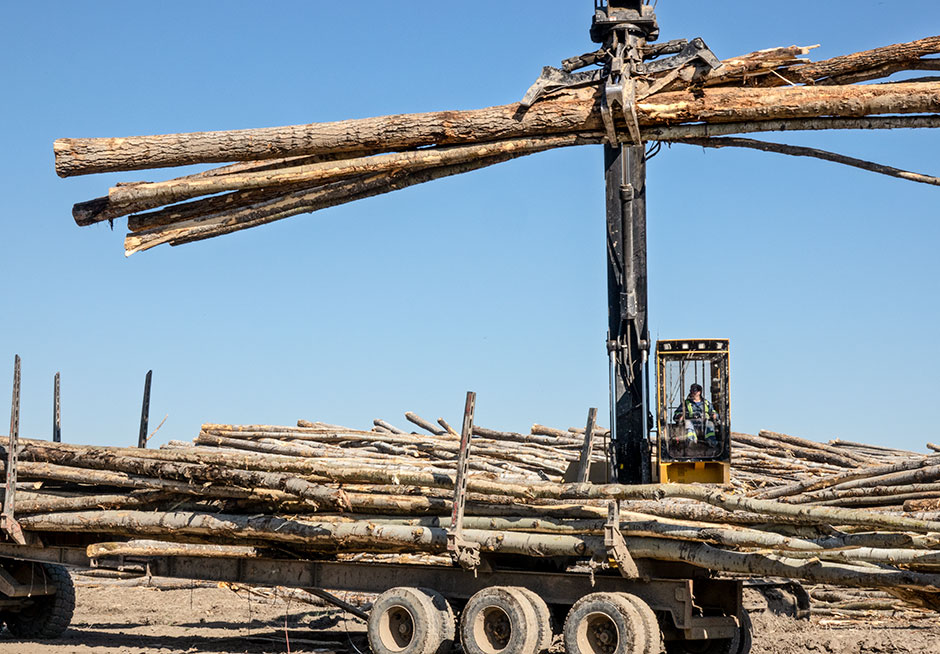
The 880D works in the stockpiles unloading the haul trucks coming from the bush, and loading the forwarding vehicle, which is currently a rock truck pulling a log trailer.
To make this happen day in and day out, last winter Peace River Logging purchased two Tigercat loaders equipped with butt-n-top grapples. An 880D stays out in the stockyard – unloading the haul trucks coming from the bush during logging season, building eight metre (25 ft) high decks, and loading the forwarding vehicle, which is currently a rock truck pulling a log trailer. The 880D, often working out of sight in the stockpiles, is equipped with Tigercat’s RemoteLogTM telematics system, enabling Bernard to keep a close eye on machine utilization.
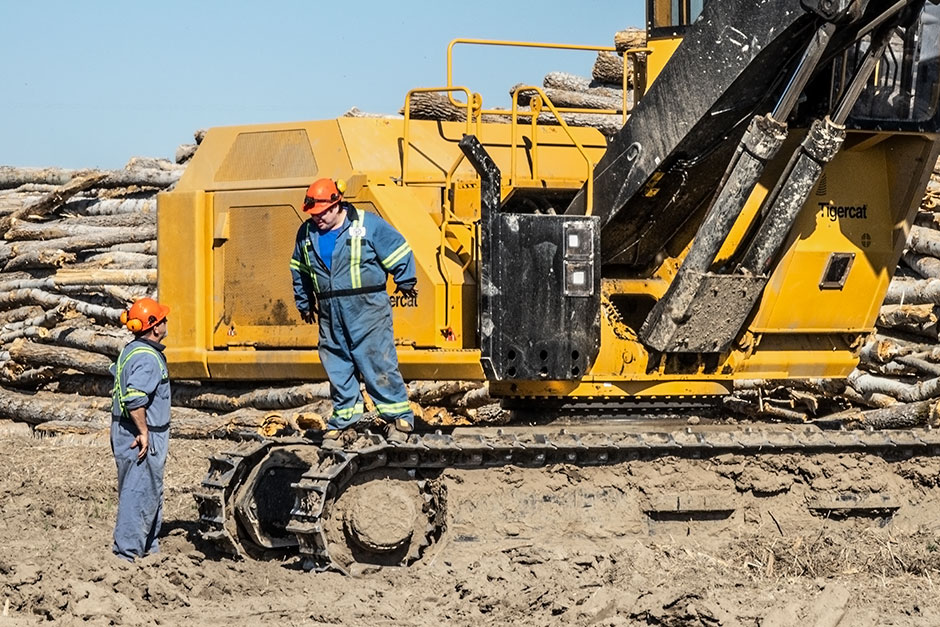
880D loader operator Stephen Cardinal with Bernard. Stephen has been with Peace River Logging for six years.
The second loader is an 875 that is stationed at the offload area adjacent to the chipper. It unloads the forwarding truck and is manned by the same operator that drives the forwarding truck. For manpower, Bernard employs one chipper operator, two loader operators, a truck driver and a lead hand for each shift. The chippers are equipped with their own cranes so the loader is not required to feed the chipper. “The next step is to think of a better way to forward the wood, maybe a dump trailer. Then we wouldn’t need to have the other machine to offload. We are always thinking of different ways to minimize our cost of retrieval.”
The mill also has an annual appetite of 275 000 tonnes of hog fuel for power generation. At the yard, the grinding operation is subcontracted but Peace River Logging is responsible to get waste material to the grinder. A wheel loader helps with clean-up and skidders equipped with front brush grapples deliver waste wood to the grinder via a ramp constructed to decrease rock content going through the grinder.
The company started in 2004 and purchased its first two bunchers in 2005. Bernard initially chose the Tigercat 870C model and the company has stuck with them, having purchased six in total. “We’ve kept all but one,” says Bernard. Peace River also runs several Tigercat 630 series skidders. Erik Lokseth was one of the original buncher operators, hired on in 2006. Today Erik holds the position of superintendent and is essentially Bernard’s right hand man.

Bernard and superintendent, Erik Lokseth. Erik started with Peace River Logging as a buncher operator in 2006.
“When we decided to purchase the butt-n-top loaders for this operation, we were looking at all of the competing models of course. But after looking at all of the machines, there was no question in my mind of what I wanted,” recalls Bernard. “The ease of working on these machines versus the other ones, just that alone made the decision easy. The other machines are not purpose-built. Another reason we went with them is that they are Canadian built and we’ve built a relationship with Tigercat and with James [Farquhar], especially with James.” Erik adds, “At three in the morning you don’t want to be spending a lot of time taking panels off just to access the machine. With the Tigercat’s, everything just flops open. It makes such a difference for maintenance and blowing out rads.” The stockyard is typically in one of three states – frozen, muddy, or in summer very dry and dusty, so easy access to the cooling system is important to Bernard and Erik. They are pumping water off of the ground in spring and running a water truck for dust control a couple of months later.
Typically, Peace River Logging will harvest throughout the summer. In late October, the five bunchers and eight skidders will move into the winter site to start harvesting well before freeze up in mid-November. Once the road is in shape for hauling, the trucks will have wood to move right away.
At three in the morning you don’t want to be spending a lot of time taking panels off just to access the machine.
With the Tigercat’s, everything just flops open. It makes such a difference for maintenance and blowing out rads.
Bernard strongly believes cross training is key to a smooth operation. For instance, 880D operator Stephen Cardinal has been with Peace River Logging six years now. He is a solid operator who can also run the chipper and skidder. At the end of the winter season, he was also trained on the bunchers. All of the wood yard crew are being cross-trained on every piece of equipment, adding flexibility to the operation.
The new system is improving chip quality by reducing bark content because Bernard is better able to manage the different species and control the drying time. “We have to meet such a high quality standard. When you are out in the bush, if the tree is there, you have to chip it. At least here, if for example we get a lot of black poplar, we can identify that and leave it until it dries up, then the bark comes off a lot easier.” When previously chipping infield there just wasn’t sufficient time or physical real estate to deck enough wood to manage the drying times like they are able to do now. “You still have to maintain a nice uniform chip size but bark is the main culprit when it comes to quality.”
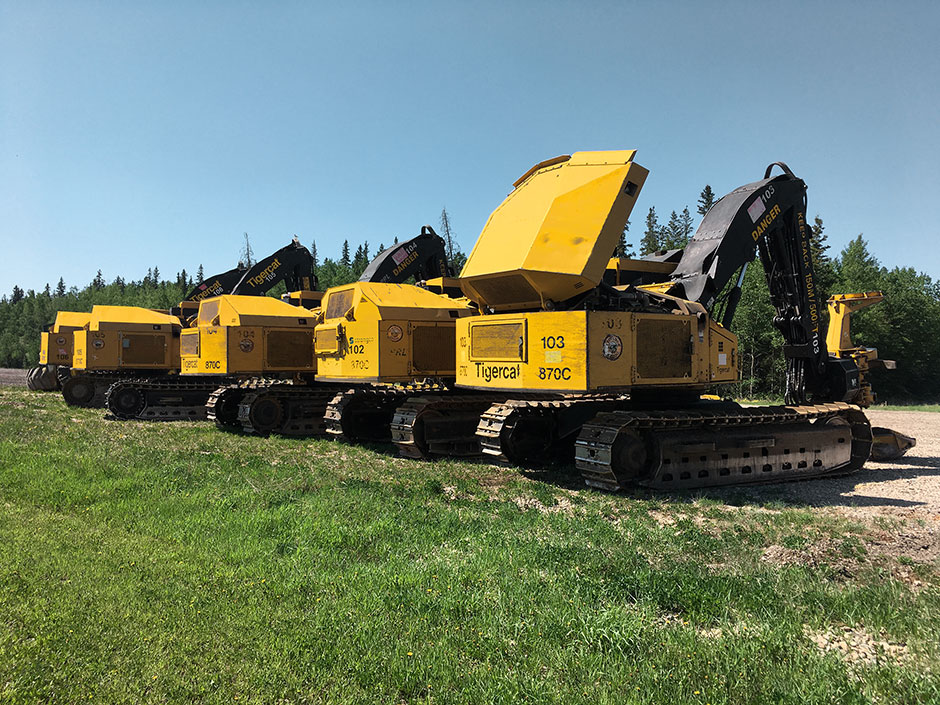
Peace River has been running Tigercat 870C feller bunchers since the inception of the company in 2004.
Bernard and Erik have also been experimenting with different degrees of delimbing to determine what works best for the new system. Bernard explains that they are currently tracking three different delimbing methods. The rough delimbed wood is essentially cut, skidded and loaded. The skidder operator drives over the tops but that is the extent of the processing. Next is a category of wood that is quickly run through a stroke delimber. The third category are trees that are delimbed with a processing head. “So now we have some decks that are fully processed, some that just got delimbed with a stroker and some that just got rough delimbed. We are going to monitor it because we have kept every deck separate. If we can get away with running it over with a skidder, we will carry on that way. It is our cheapest method – we don’t have to run it through another phase.” What Bernard and Erik are monitoring is breakage. The worry is that as the 880D logger is wrestling the tangled branches free from the deck that breakage is going to occur. Bernard doesn’t want broken limbs left lying on the roads and scattered throughout the stockpile area. Peace River Logging has paid to get that fibre down to the yard and wants to convert it all to chips. And broken limbs on the road make for flat tires as the rock truck and trailer is constantly forwarding from the decks to the chipper. So far Bernard has observed that excess debris has not been an issue, boding well for the rough limbing method. When the 880D is waiting for the forwarding truck to turn around, the operator spends his time cleaning up broken limbs. “We try to keep it clean and we want to try and maximize our usage,” says Bernard. Anything that cannot be chipped is gathered, piled and delivered to the subcontracted grinder that is working five days a week. The material is converted to hog fuel for power generation at the mill, so the operation is achieving near 100% utilization. When the old system was in place, a lot of this fibre stayed in the bush and was wasted.